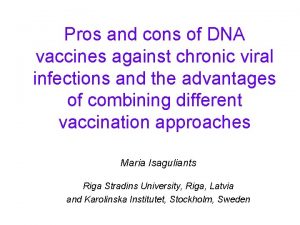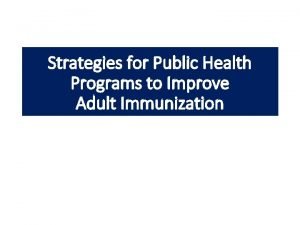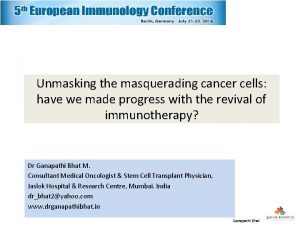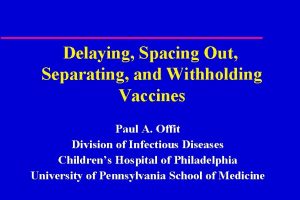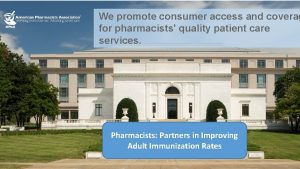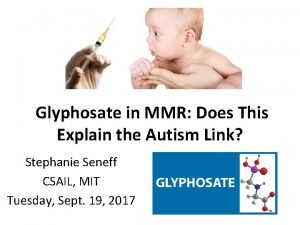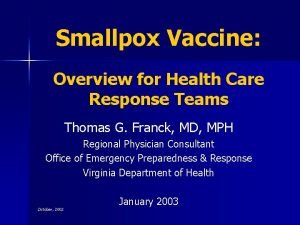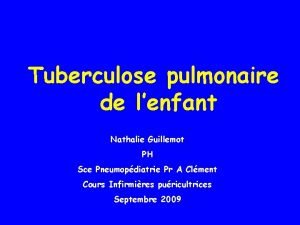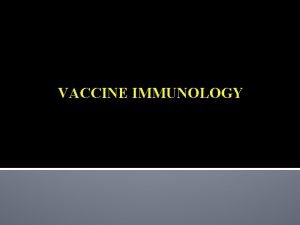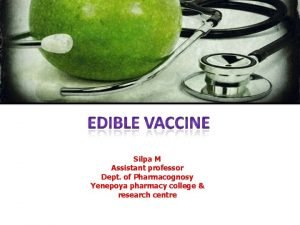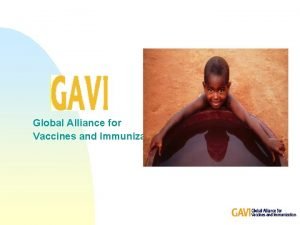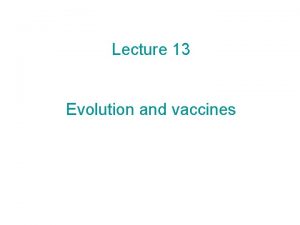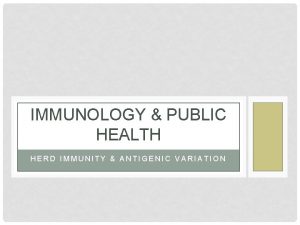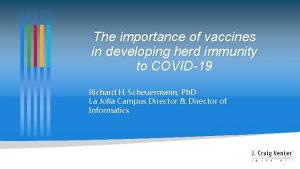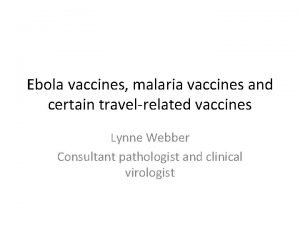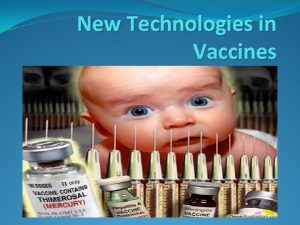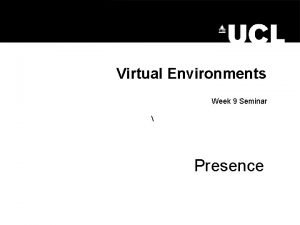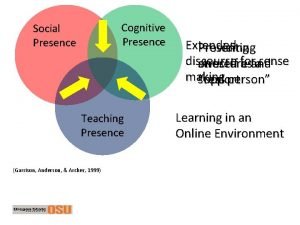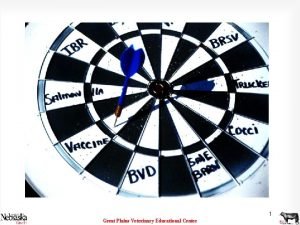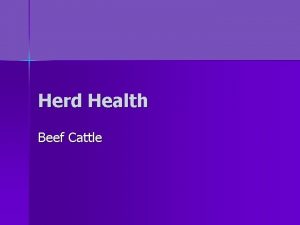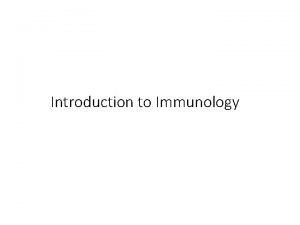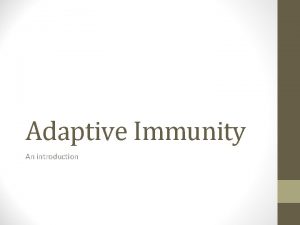Vaccines HERD IMMUNITY presence of immunity in MOST














- Slides: 14

Vaccines

• HERD IMMUNITY: presence of immunity in MOST of the population – inability of an infectious disease to spread in a population because of the lack of a critical concentration of non-immune hosts (Resistance of a population to infection and to spread of an infectious organism because of the immunity of a large percentage of the population) • Level can be altered by introduction of new susceptible individuals into population • Level can be altered by changes in pathogen • Antigenic shift – major change in antigenic character of pathogen 2 Herd Immunity

Some Examples of Emerging and Reemerging Infectious Diseases and Pathogens = New, reemerging or drug-resistant infections whose incidence in humans has increased within the past three decades or whose incidence threatens to increase in the near future

Crowding (population growth) Habitat disruption (urbanization) Increased international travel, migration Increased worldwide transport Changes in food processing, handling, agricultural practices Changes in human behavior Changes in ecology and climate Modern medicine (ex. immunosuppression; excessive or inappropriate antibiotic use) • Inadequacy of public infrastructure and vaccination programs • Bioterrorism • • 4 Some Reasons for Increases in Emerging and Reemerging Infectious Diseases

How to Control the Spread of Diseases 1. Control the reservoir (i. e. control at the source) Animal → immunization or slaughter • • • Ex. Immunize cattle against E. coli O 157 to prevent entry of the bacteria into the human food chain Human → isolate infected host (prevent contact) Prompt diagnosis & treatment of infected hosts Try to identify & treat carriers (difficult to do) Environment → de-contaminate or avoid contact 5 •

Control transmission • • • 3. Remove vectors (ex. pesticide control of insects) Prevent contamination of fomites (ex. use disinfectants) Chlorination of water supplies Pasteurization of milk Supervision and inspection of food and food handlers Cover your sneeze, wash your hands, etc. Control the Susceptible Population • • Promote healthy lifestyle (hygiene, nutrition, etc. ) Avoid high-risk behaviors Use vaccine (if available) Raise herd immunity 6 2.

4. Establish a “Disease Control Network” • Network of individuals and organizations who identify, track, and control infectious diseases • Health care workers • Epidemiologists • Diagnostic labs 7 • Local, national, and international public health organizations

Five public health practices that have had the greatest success in decreasing the incidence of infectious diseases: 1. Ensuring a clean water supply 2. Ensuring a clean food supply 3. Promoting personal cleanliness and hygiene 4. Controlling insect vectors 5. Public education campaigns focused on STD’s and respiratory diseases • → On average, incidence of infectious diseases and mortality due to microbial pathogens have declined greatly in last 100 years (due to more effective control practices, better diagnosis, better drugs, etc. )

VACCINATION (immunization): intentional administration of a harmless or less harmful form of a pathogen to induce a specific immune response that protects the individual against later exposure to the same pathogen • May consist of killed, living, weakened (attenuated) microbes or inactivated bacterial toxins (toxoids), purified cell material, recombinant vectors or DNA • Vaccines attempt to induce antibodies and activated T cells to protect host from future infection 9 VACCINE: Preparation of microbial antigens used to induce protective immunity

Vaccination is a medical miracle

Active Immunity: • Vaccine induces immune response in host that will not result in disease (recipient makes own antibodies) • Whole Agent Vaccines: • Killed or attenuated (weakened) microorganisms • Subunit Vaccines: • Contain some part or product of the microorganism that can induce an immune response in the recipient • Forms of subunit vaccines • capsular polysaccharides • recombinant surface antigens • inactivated exotoxins (toxoids) 11 • Contain whole, nonvirulent microorganisms

• DNA directly introduced into host cell via air pressure or gene gun • When injected into muscle cells, DNA taken into nucleus and pathogen’s DNA fragment is expressed • Host immune system responds to foreign proteins produced • Many DNA vaccine trials are currently being run 12 DNA Vaccines


Adjuvants • An adjuvant is a chemical substance that can be added to a vaccine in order to enhance the immune response to the vaccine. • Alum or Freud’s 14
 Difference between acquired immunity and innate immunity
Difference between acquired immunity and innate immunity Edible vaccines pros and cons
Edible vaccines pros and cons Dna vaccines pros and cons
Dna vaccines pros and cons Hep b vaccines
Hep b vaccines Cancer vaccines
Cancer vaccines Spacing out vaccines
Spacing out vaccines Hep b vaccines
Hep b vaccines Glyphosate in vaccines
Glyphosate in vaccines History of vaccines pdf
History of vaccines pdf Tubertest lecture
Tubertest lecture Shine skis encapsulated
Shine skis encapsulated Edible vaccines in pharmacognosy
Edible vaccines in pharmacognosy Edible vaccine definition
Edible vaccine definition Global alliance for vaccines and immunization
Global alliance for vaccines and immunization Could vaccines breed viciousness
Could vaccines breed viciousness


